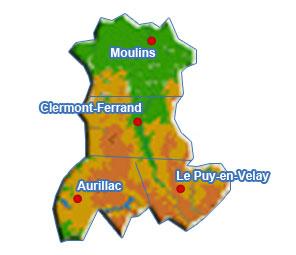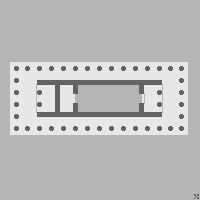|
Fanum D'Aron
Fanum d'Aron is a fanum, or Romano-Celtic temple, located in Aurillac, a French commune in the Auvergne region. Site and status Discovered in 1970 in the southwest of Aurillac, the temple was excavated from May 1977 through the end of 1978 and added to the ''monuments historiques'' registry in 1980. It is situated in what is now a small municipal garden, between a pavilion and the Lescudilier industrial zone (cadastre BE n°360). History Salvage excavations have recovered rich materials from the site, including lapidary pieces, glass and metallic artifacts, coins, eight column capitals (four of which feature sculpted trachyte heads representing the Sun and Moon), a fluted column barrel fragment, and ceramics as well as terracotta antefixes. These objects establish that the temple would have been in use from the 1st to 3rd centuries CE. Some artifacts and architectural elements from the site are kept on display at the Aurillac Museum of Art and Archeology, along with ... [...More Info...] [...Related Items...] OR: [Wikipedia] [Google] [Baidu] |
Auvergne
Auvergne (; ; or ) is a cultural region in central France. As of 2016 Auvergne is no longer an administrative division of France. It is generally regarded as conterminous with the land area of the historical Province of Auvergne, which was dissolved in 1790, and with the now-defunct administrative region of Auvergne, which existed from 1956 to 2015. The region is home to a chain of volcanoes known collectively as the " chaîne des Puys". The volcanoes began forming about 70,000 years ago, and most have eroded, leaving plugs of hardened magma that form rounded hilltops known as puys. The last confirmed eruption occurred around 4040 BCE. Geography Auvergne is known for its mountain ranges and dormant volcanoes. Together the Monts Dore and the Chaîne des Puys include 80 volcanoes. The Puy de Dôme is the highest volcano in the region, with an altitude of . The Sancy Massif in the Monts Dore is the highest point in Auvergne at . The northern part is covered in hil ... [...More Info...] [...Related Items...] OR: [Wikipedia] [Google] [Baidu] |
Cella
In Classical architecture, a or naos () is the inner chamber of an ancient Greek or Roman temple. Its enclosure within walls has given rise to extended meanings: of a hermit's or monk's cell, and (since the 17th century) of a biological cell in plants or animals. Greek and Roman temples In ancient Greek and Roman temples, the ''cella'' was a room at the center of the building, usually containing a cult image or statue representing the particular deity venerated in the temple. In addition, the ''cella'' might contain a table to receive supplementary votive offerings, such as votive statues of associated deities, precious and semi-precious stones, helmets, spear and arrow heads, swords, and war trophies. No gatherings or sacrifices took place in the ''cella'', as the altar for sacrifices was always located outside the building along the axis and temporary altars for other deities were built next to it. The accumulated offerings made Greek and Roman temples virtual treasuri ... [...More Info...] [...Related Items...] OR: [Wikipedia] [Google] [Baidu] |
Allanche
Allanche (; ) is a commune in the Cantal department in the Auvergne region of south-central France. Geography Allanche is located some 70 km south of Clermont-Ferrand and 20 km east by southeast of Massiac. It can be accessed by the D679 from Marcenat in the northwest to the village then south to Sainte-Anastasie. The D39 comes from Pradiers in the north through the village then south to Chalinargues. The D9 road branches off the D3 to the west of the commune and passes through the village continuing to the northeast. Apart from the village there are a number of hamlets. These are: *Chastre *Chavanon *Coudour *Feydit *Le Bac Bas *Le Bac Haut *Les Cites *Maillargues *Roche Haut *Romaniargues The commune is largely farmland with patches of forest and the edge of a large forest in the east. The ''Allanche'' river flows from the northwest through the village and continues southeast to feed the Alagnon river. Many tributaries feed the Allanche in the commune including ... [...More Info...] [...Related Items...] OR: [Wikipedia] [Google] [Baidu] |
Landeyrat
Landeyrat (; ) is a commune in the Cantal department in south-central France. Population See also *Communes of the Cantal department The following is a list of the 246 Communes of France, communes of the Cantal Departments of France, department of France. Intercommunalities The communes cooperate in the following Communes of France#Intercommunality, intercommunalities (as ... References Communes of Cantal {{Cantal-geo-stub ... [...More Info...] [...Related Items...] OR: [Wikipedia] [Google] [Baidu] |
Chassenon
Chassenon (; ) is a commune in the Charente department in southwestern France. History The ancient name of the village was ''Cassinomagus''. Situated on the Agrippan Way (Lyon - Saintes), Cassinomagus was, in the Roman times, important enough to be mentioned on the mediaeval Peutinger map as one of the two secondary towns between Limoges and Saintes. The remains of this Gallo-Roman town lay on about 300 hectares and include a sanctuary of about 25 hectares. This sanctuary consisted of several monuments: a big temple, two small ones, a theatre (amphitheatre ?), and thermal baths. The baths, which are very well preserved, can be visited. The impactite, which is part of the Rochechouart impact structure, was quarried north-west of Rochechouart near Chassenon, was the stone principally used in the building of the monumental Roman baths of Cassinomagus.Cécile Doulan et al., eds, ''Dossier: Cassinomagus: l'agglomération et ses thermes. Résultats des recherches récentes (2 ... [...More Info...] [...Related Items...] OR: [Wikipedia] [Google] [Baidu] |
Saint-Gervais, Vendée
Saint-Gervais () is a commune in the Vendée department in the Pays de la Loire region in western France. Population See also *Communes of the Vendée department The following is a list of the 253 communes of the Vendée department of France. The communes cooperate in the following intercommunalities (as of 2025):Communes of Vendée {{Vendée-geo-stub ... [...More Info...] [...Related Items...] OR: [Wikipedia] [Google] [Baidu] |
Mauriac, Cantal
Mauriac (; ) is a Communes of France, commune in the Cantal Departments of France, department in the Auvergne (region), Auvergne Regions of France, region in south-central France. It lies north-northwest of Aurillac by rail. Mauriac, built on the slope of a volcanic hill, has a medieval church, and the buildings of an old abbey now used as public offices and dwellings; the town owes its origin to the abbey, which originated from a 6th-century foundation. Geography Mauriac is situated in the northwest of Cantal, close to the border with the Corrèze and Limousin (region), Limousin departments. The greater part of the Mauriac arrondissement is watered by the Saint-Jean, a brook which flows past the southwestern edge of the town and fills the lac du Val Saint-Jean, a small reservoir, before flowing into Auze (Dordogne), Auze, an important tributary of the Dordogne (river), Dordogne. Mauriac is in hilly terrain, with the main populated area falling into a zone at an altitude ... [...More Info...] [...Related Items...] OR: [Wikipedia] [Google] [Baidu] |
Vellavi
The Vellavii (Gaulish: *''Uellauī/Wellawī'') were a Gallic tribe dwelling around the modern city of Le Puy-en-Velay, in the region of the Auvergne, during the Iron Age and the Roman period. Name They are mentioned as ''Vellaviis'' (var. ''vellabiis'') by Caesar (mid-1st c. BC), ''Ou̓ellaoúioi'' (Οὐελλαούιοι, var. -άοιοι, -άϊοι) by Strabo (early 1st c. AD), ''Vellavi'' (var. ''velavi'') by Pliny (1st c. AD), ''Ou̓éllaunoi'' (Οὐέλλαυνοι, var. Οὐέλλενες) by Ptolemy (2nd c. AD), and as ''Velavorum'' in the '' Notitia Dignitatum'' (5th c. AD).'' Notitia Dignitatum'', oc 42:68., s.v. ''Vellavi''. The city of Le-Puy-en-Velay, attested ca. 400 AD as ''civitas Villavorum'' ('civitas of the Vellavii'), and the region of Velay Velay () is a historical area of France situated in the east Haute-Loire ''Département in France, département'' and southeast of Massif central, Massif Central. History Julius Caesar mentioned the vellavi ... [...More Info...] [...Related Items...] OR: [Wikipedia] [Google] [Baidu] |
Sondage
A sondage is an archaeological process to clarify stratigraphic sequences during preliminary investigations of the terrain prior to an archaeological dig. In a narrower sense it is a "deep trial trench for inspecting stratigraphy". at collinsdictionary.com. Retrieved 10 December 2021. In doing so, several approximately test excavations are carried out over the area, as far as possible down to the 'natural soil' level. Clearly recognizable layers of sediment
Sediment is a solid material that is transported to a new location where it is deposited. It occurs naturally and, thr ...
[...More Info...] [...Related Items...] OR: [Wikipedia] [Google] [Baidu] |
Terracotta
Terracotta, also known as terra cotta or terra-cotta (; ; ), is a clay-based non-vitreous ceramic OED, "Terracotta""Terracotta" MFA Boston, "Cameo" database fired at relatively low temperatures. It is therefore a term used for earthenware objects of certain types, as set out below. Usage and definitions of the term vary, such as: *In art, pottery, applied art, and craft, "terracotta" is a term often used for red-coloured earthenware sculptures or functional articles such as flower pots, water and waste water pipes, and tableware. *In archaeology and art history, "terracotta" is often used to describe objects such as figurines and loom weights not made on a potter's wheel, with vessels and other objects made on a wheel from the same material referred to as earthenware; the choice of term depends on the type of object rather than the material or shaping technique. *Terracotta is also used to refer to the natural brownish-orange color of most terracotta. *In architecture, ... [...More Info...] [...Related Items...] OR: [Wikipedia] [Google] [Baidu] |
Corinthian Capitals
The Corinthian order (, ''Korinthiakós rythmós''; ) is the last developed and most ornate of the three principal classical orders of Ancient Greek architecture and Roman architecture. The other two are the Doric order, which was the earliest, followed by the Ionic order. In Ancient Greek architecture, the Corinthian order follows the Ionic in almost all respects, other than the capitals of the columns, though this changed in Roman architecture. A Corinthian capital may be seen as an enriched development of the Ionic capital, though one may have to look closely at a Corinthian capital to see the Ionic volutes ("helices"), at the corners, perhaps reduced in size and importance, scrolling out above the two ranks of stylized acanthus leaves and stalks ("cauliculi" or ''caulicoles''), eight in all, and to notice that smaller volutes scroll inwards to meet each other on each side. The leaves may be quite stiff, schematic and dry, or they may be extravagantly drilled and undercut, n ... [...More Info...] [...Related Items...] OR: [Wikipedia] [Google] [Baidu] |
Acanthus (plant)
''Acanthus'' is a genus of about 30 species of flowering plants in the family Acanthaceae, native to tropical and warm temperate regions, with the highest species diversity in the Mediterranean Basin and Asia. This flowering plant is nectar-producing and depends on butterflies, such as '' Anartia fatima'', and other nectar-feeding organisms to distribute its pollen. Common names include Acanthus and bear's breeches. The generic name derives from the Greek term (''akanthos'') for '' Acanthus mollis'', a plant that was commonly imitated in Corinthian capitals. The genus comprises herbaceous perennial plants, rarely subshrubs, with spiny leaves and flower spikes bearing white or purplish flowers. Size varies from in height. Species 29 species are accepted: #'' Acanthus albus'' #'' Acanthus arboreus'' Forssk. (1775) #'' Acanthus austromontanus'' Vollesen — This species is native to southwestern Tanzania #'' Acanthus carduaceus'' #'' Acanthus caroli-alexandri'' (Syn. ' ... [...More Info...] [...Related Items...] OR: [Wikipedia] [Google] [Baidu] |



